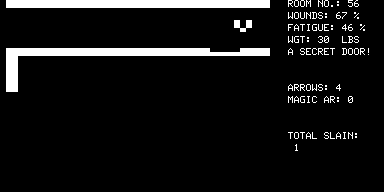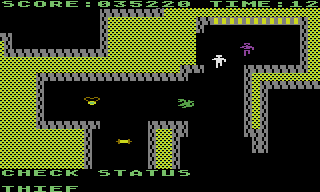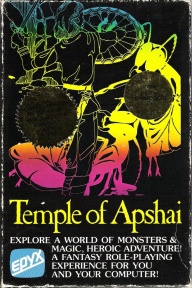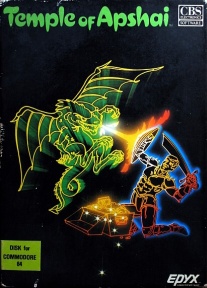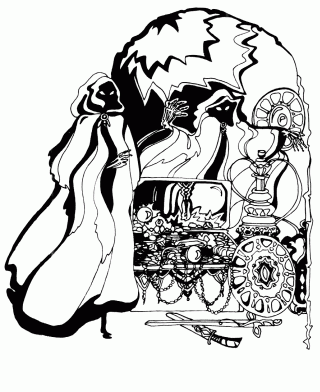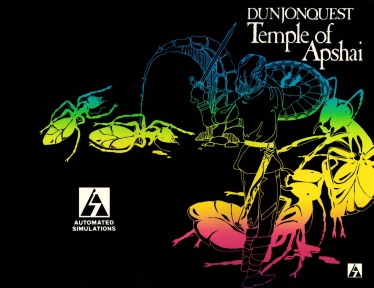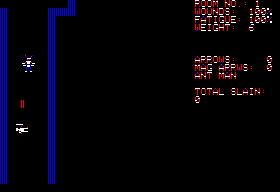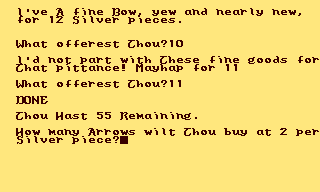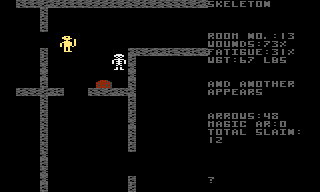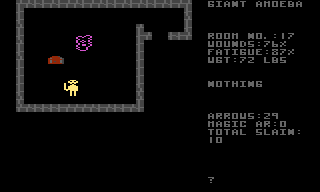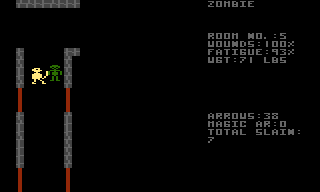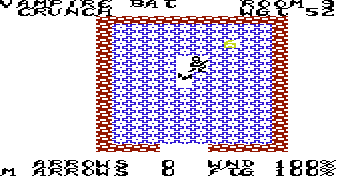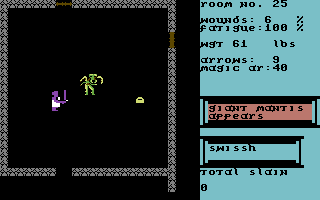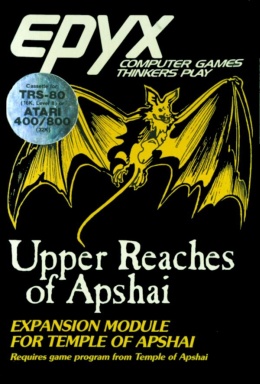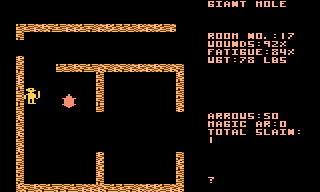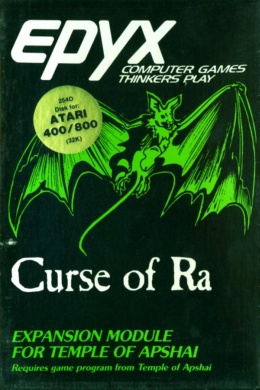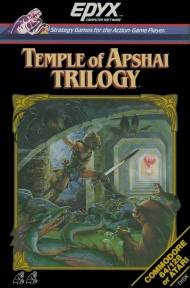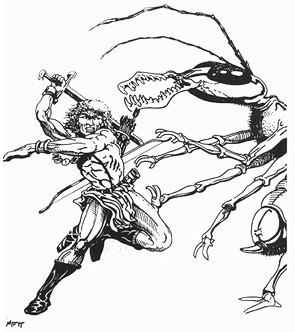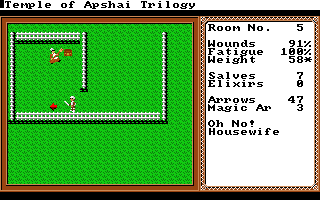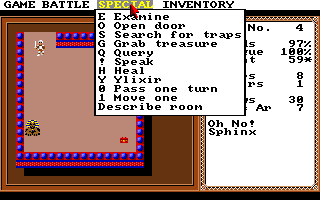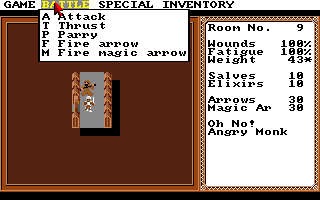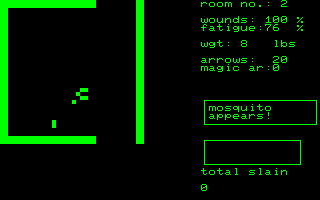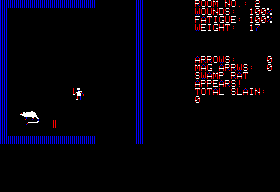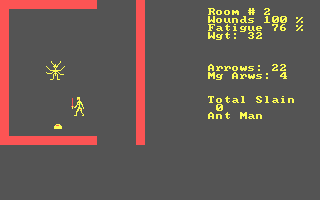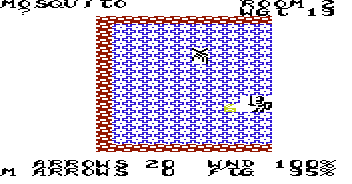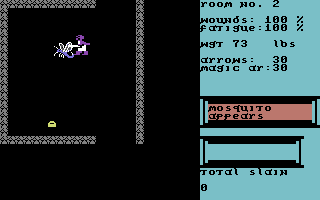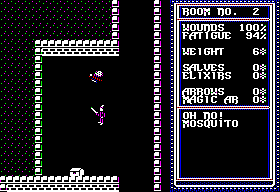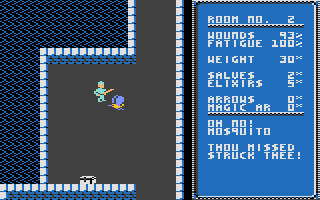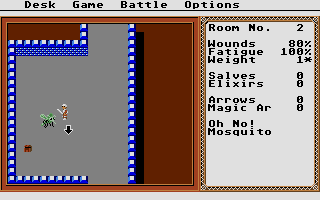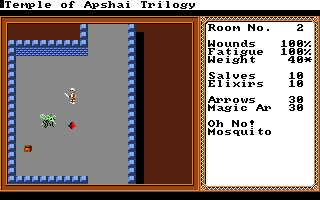
|
<<< Prior Page |
|
Page 1: |
Page 2: |
Page 3: |
Most gamers with an interest in the history of their hobby have at least heard of Wizardry. Ultima will ring a bell, too. Even though both franchises' main series are long discontinued, their legacy is kept alive. Japan consistently churns out new spin-offs to Wizardry almost every year, while Ultima Online is still the oldest commercially used MMO, with most remaining subscribers once again based in Japan.
Namedropping Dunjonquest, on the other hand, is more likely to cause people turn on their browser's spell check. Only the most old school will remember that label adorning the box of the first commercial hit RPG ever. Automated Simulations - later renamed much more familiarly Epyx - created and published Temple of Apshai in 1979, predating both Wizardry and Ultima (although we'll likely never know for sure if the DIY-version of Akalabeth was released earlier). The game was such a huge success that it entailed more than 10 sequels, mission packs and spin-offs within only a few years. How come that this series has all but vanished from gamers' collective memory while its competitors can be sensed in most electronic RPGs until today, both in western and far eastern tradition? Before trying to answer that question, a brief look at the roots of computer RPG gaming and the early history of Epyx is in order.
Computer-assisted fantasy role playing started as early as the mid-1970s. Dungeons & Dragons had just been released in 1974, and the more nerdy students at several technical universities were often prone to "abuse" the institutes' mainframe computers for their new hobby. This didn't stop at mere tools for the dungeon master: Soon inventive role players came up with ways to cram an entire portion of the experience into the machine - the dungeon crawl computer game was born. Programs like pedit5 (first version 1974), dnd (1975) or Moria (1978?) followed Dungeons & Dragons in its rise to popularity and were eagerly shared among students, and in the case of Moria even used for cooperative online play on multiple terminals. Contrary to Wizardry, though, there is no indication that Dunjonquest was influenced ever influenced by the PLATO forefathers. Connelley had been in college during the 1960s, before any of the mainframe dungeon crawls took shape. Jon Freeman and Jeff Johnson seem to have been part of the working world for several years as well (Freeman was born 1945). What all main creators of Dunjonquest had in common, though, was the fact that they played in the same Dungeons & Dragons group.
pedit5, the oldest known mainframe dungeon crawl
In analogy to the history of CRPGs overall, Epyx' story likewise begins with Dungeons & Dragons. Jim W. Connelley had bought his Commodore PET computer originally to help him manage his Dungeons & Dragons sessions he led as a dungeon master. Of course a computer for home use was no marginal investment at the time, and so he decided to produce and sell a computer game to get back his money's worth. His partner should become Jon Freeman, a player at his D&D campaign, and a board- and war game journalist/creator himself. Together they first conceived the SciFi war game Starfleet Orion and released it around christmas 1978 as Automated Simulations - the Epyx label was introduced some time later, initially just as a brand name. A sequel called Invasion Orion followed the next year, but soon their passion for Dungeons & Dragons encroached on their new found profession.
Similar in structure to many of the mainframe dungeon crawls but with unequaled complexity, yet using a (for the time) very user-friendly interface and - maybe even more importantly - commercially published for home computers, Temple of Apshai was hailed by critics and gamers alike as the best game of its time. It was also one of the first RPGs to ever become distributed as a professionally packaged product for home use, even before Richard Garriott's Akalabeth was commercially published (although the time frame for his dozen of DIY tapes remains a point of contention). The tape was still contained in a plastic bag rather than an actual box, but it came with a big 56-page manual. Its greatest strength were the colorful room descriptions available in this "Book of Lore".
Automated Simulations still presented Dunjonquest to the user as an alternative to the bothersome task of managing a conventional pen-and-paper RPG campaign. Therefore, the episodes were handled as modules for a common role playing system, much like adventure books in PnP circles. Every room in the game has a number attached to it, which can be looked up in the manual to supplement the meager and monotonous graphics with fantasies of underground rivers, collossal statues or other such peculiarities. The descriptions are no mere flavor text, though, and provide hints of hidden passages, traps and treasures. The presence of Antmen, for whatever reason, is always indicated by a scent of vanilla.
At the end of 1981, Jon Freeman left the company to form Free Fall Associates together with his wife Anne Westfall. The two as a team became known mostly for creating the board/action game hybrid Archon. The final expansions for the major Dunjonquest games were created without his participation, but soon the series came to an end. Epyx continued to port the games to several platforms, but the only entirely new game to follow after Freeman's leave was Gateway to Apshai (1983), an action RPG spin-off to the Temple of Apshai trilogy. By that time Michael Katz had already taken the reins at Epyx, and Connelley worked as an outside contractor to Epyx with his new company The Connelley Group. After the success of Jumpman in 1983 the new management of the restructured company decided to concentrate its main efforts towards action games.
In 1985, around the same time when Epyx started to publish various ports of Rogue, it also released the Temple of Apshai Trilogy, a remake of the most successful Dunjonquest mini-series. This version was redesigned by Stephen Landrum, but other than the obious graphics and interface improvements left the actual gameplay unchanged. In that form the game obviously had little hope to compete on the market with contemporaries such as Ultima IV, Wizard's Crown or The Bard's Tale and thus remained the only, futile effort to revive the series. Dunjonquest therefore was never given opportunity to develop into more complex and refined territory with age like its early competitors did.
Yet it is not only the early discontinuation that divides Dunjonquest from its more famous rivals. It is also important to note that the series was never big in Japan (in fact, it doesn't seem like any of the games have ever been released over there) and didn't at all exert the formative influence over the JRPG tradition that Ultima and Wizardry enjoyed. Nonetheless Dunjonquest remains an important part of RPG history, even if its influence is felt more indirectly. Most of all, it proved that a CRPG could be a mainstream success, extending the genre's reach beyond nerdy TI student networks. It also paved the way for the birth of action RPGs with its pseudo-realtime combat engine.
Acknowledgements and Sources
- Big thanks go to Trypticon over at the The Legacy community, for lots of valuable information and files concerning the less accessible ports.
- The Museum of Computer Adventure Game History showcases a huge amount of scans from vintage computer game boxes, manuals and other materials, not limited to DunjonQuest; a visit is highly recommended.
- Epyx Shrine (archived by The Wayback Machine).
- Epyx History at GOTCHA.
- Interview with Jon Freeman and Anne Westfall from Halcyon Days: interviews with classic computer and video game programmers by James Hague; available at Dadgum games.
- Ira Goldklang's TRS-80 Revived Site contains various materials related to one of the earliest home computers.
- Finally, those who desire to relive the first hours of computer RPG gaming shall be pointed towards the cyber1 community and their PLATO Terminal Emulator.
Print Sources:
Compute! Fall 1979 - 32K Programs Arrive: Fantasy Role Playing Game For The PET (1) (2) by Ben Lindsay
Byte December 1980 - Character Variation in Role-Playing Games (1) (2) (3) by Jon Freeman
InfoWorld November 5th, 1981 - This Company Is Serious about Games (1) (2) by Paul Freiberger
Compute! Gazette September 1983 - Jim Connelley: The Programmer Behind Temple Of Apshai (1) (2) by Kathy Yakal
When thinking of stories in vintage video games, the default assumption is a 2-paragraph background overview in the manual - not so with Dunjonquest. The introductions for some of these games are almost like tiny fantasy short-stories that fill multiple pages. Especially Temple of Apshai's setting is miles away from generic "save the world, beat the boss and/or get the girl"-clichés that came to dominatee the genre later:
For generations, no one has laid eyes upon the old temple of the forgotten ant god Apshai. Envied for their wealth but feared for rumors of dark rituals, its followers were driven into an underground realm centuries ago by the followers of Geb, god of the earth. Deep inside the caverns, they built their city and temple, but in the end they were destroyed by divine intervention and the ruins buried under the earth.
Only recently, high priest Nemdal Geb ordered the excavation of the now but legendary ruins. The temple and its riches were indeed found, but after a short time work parties in the fourth passage of the temple started to disappear, and soon the whole complex became once again inaccessible. Desperate about the decline in population and profits from the temple, the high priest himself led a party of the greatest warriors in town into the depths, only for none of them to ever return.
Temple of Apshai's rich supplemental material presents this tale to Brian Hammerhand, the iconic hero of the Dunjonquest series. It doesn't have to be him who enters the dunjons (a variant on old English / original French spelling for dungeon), though, as the game offers a rather particular form of character generation. Players can either have the game create a new character at random, or enter their own, completely at their discretion; stats, experience, inventory and all. Going with this function, Automated Simulations encouraged players to carry over characters used in Dungeons & Dragons and other pen & paper RPGs - early advertisements even promoted the game as a "version of Dungeons and Dragons".
Granted, the possibilities for characters are rather limited. Dunjonquest uses a system based on 6 main characteristics, compatible with many popular PnP rulesets, but knows no races nor classes, nor any magical spells. The available equipment is very sparse, as well. The import function was more useful as a savegame ersatz (when no free save disk was available, or for mistrust towards the glitchy character save routine in some versions - or for users of the tape versions, which didn't support saving at all), as well as to transfer characters to following Dunjonquest episodes. It takes no expert on human nature, of course, to guess that in practice it was mostly used for cheating. It should not be forgotten, though, that the game is a child of the pen & paper mentality and as such trusts the players to confront themselves with proper challenges according to publisher reccomendation.
The character generation process is part of the "inn" program (early versions of the game were programmed in BASIC), which also co-functions as a shop for weapons and items (haggling is also possible) and, last but not least, a hub to enter all four levels of the temple. Temple of Apshai uses an open-ended structure, the quest merely being to plunder the temple and get filthy rich. So all the levels are accessible from the very beginning, although a fresh, uncheated character is likely to get slaughtered fast in the higher levels. Dying doesn't neccessarily mean game over, though, as there is a chance to be rescued by one of three other adventurers. The dwarf, however, demands all gold and treasures for his services. The magician takes away all magical items. Only the priest is content with a small donation for his sect.
When entering the top-down view DunjonMaster module for the first time, the controls can be very off-putting when accustomed to today's standards. The game is exclusively controlled with the keyboard, there is no WASD scheme here (Wizardry brought that from the mainframes to home computers later). In old-fashioned text adventure-ish manner, "l" makes the character turn left, "r" stands for right. To move forward, the player has to press a number key from 1 to 9, which determines the movement "speed" for this turn, but also the amount of fatigue the move is going to cost. All other actions have their own hot keys, as well.
What Dunjonquest lacks in character creation options, it more than makes up for in the extraordinarily satisfying dunjon crawls. The game makes very meaningful use of the six base statistics, so a high intuition makes the hero more likely to find hidden doors and traps, for example. With each move the character grows tired based on carrying weight, strength and even the severity of wounds. When the fatigue rating drops to zero below, the adventurer cannot move or fight until recovered, leaving him an easy pray for near beasts. The fatigue system adds a nice extra layer of tactics to the game and is much more well thought out than the need to carry food around and consume with every step in many early RPGs.
The core of the game is made up by an inventive and complex (for 1979) combat system. Besides the standard attack, it's also able to thrust towards enemies for a damage bonus, but this comes at the cost of leaving oneself more open for counter attacks. Parry on the other hand has the opposite effect and is also valuable to conserve stamina. But the most resourceful adventurers try to stay at a distance and penetrate their more dangerous foes with arrows. But monsters don't wait for players to carefully think through their strategy. Not forever, anyway. They move in a kind of active turn-based intervals, which can be set between three levels at the beginning of the game. After each of the player's moves they strike definitely, though, and due to the structure of the program, they even get a final move after being hit by a deadly stroke. So there's no time to be lost, but not much room for careless decisions, either. It's even possible to try and talk monsters out of the fight, or to just run away. The creatures never leave their room, but stay there lurking for forgetful adventurers on their way back out of the dunjon. The combat in Temple of Apshai was certainly much more complex and thrilling than anything seen before in the mainframe proto RPGs.
In Temple of Apshai, there is no finish line, no target other than making it back to the entrance alive with as much loot as possible. Level 4 is home to an unique enemy that could be viewed as a boss of some kind, but it doesn't end the game or anything, and can even be skipped altogether by exploiting a glitch. When returning to the inn, the games' open design becomes a bit much, though, as it honestly asks players to calculate the value of their treasures themselves and enter the total amount of gold earned by hand. At least the game manages the gained experience points, although it doesn't count character levels and the actual effects of gaining experience are kept obfuscated.
In the floppy disk versions of the game, dunjon states and characters can be saved and loaded separately, so there's the choice to either conquer the levels over multiple sittings, or have them reset for future raids. Once again it's up to the players to pick their challenges. When aiming to clear out a level in one go, skillful resource management is imperial. Weapons and armor may break and can only be replaced by what is found in the dunjon, an inventory for spare equipment doesn't exist. Valuable arrows and healing salves can be carried in limited quantity only. If it wasn't for the lack of randomly generated dunjons and meaningful permadeath mechanics, Temple of Apshai would have been a almost a roguelike experience.
It shouldn't surprise at all that Temple of Apshai doesn't have a lot going for it visually. The original TRS-80 version uses particularly abstract graphics, but even in the more advanced ports the dunjons look sparse and monotonous. In place of fancy graphics stand textual descriptions of the rooms, once again very akin to text adventures, as both find their roots in the choose-your-own-adventure type books of the '70s. These descriptions, however, are not displayed on screen. Disk space limitations forced the Automated Simulations guys to move all those to the manual, or "Book of Lore." In fact, it almost feels half like playing an adventure game book. It certainly doesn't represent what a 21st century player's mind is conditioned to expect from a video game, but the nostalgic leafing through the pages in front of the screen is a reminder of times when commercially successful games could explore new possibilities that don't revolve around visual pomp.
Each room comes with an unique number, which is to be looked up in the manual for a detailed description of the surroundings. This not only supports the imagination of dark, moldy caverns, but also gives valuable hints for exploration. A typical room desctription may read like this:
Room Fifty-six-is a passage with rough stone walls and floor and a native granite ceiling. The south wall of the passage is faced with smooth squarish stones near the far end, while the floor and other walls are of a rough stone. A foul, musty odor fills the air and a thin layer of moss coats the floor at the extreme end of the passage.
Keen adventurers know by now that they have to search for secret doors in the southern wall, and there might even be a minor treasure (incense moss) waiting in the next room on the far side of the passage. Treasures are equally number coded, although here the same number might be re-used several times. Most of the loot is sold upon return to the inn, only occasionally the search is rewarded with magical equipment - or punished with cursed items.
Temple of Apshai was first conceived and programmed for the Tandy-Radio-Shack-80 and Commodore PET, but soon ported to Apple II computers by Michael Farren. This version replaces the abstract pictographs of the original with character graphics that actually try to look like fantasy creatures. When facing north or south, the side view of the character is just tilted by 90 degrees, which is sometimes confusing in determining the right direction to turn around. There was also a second release that added an animated intro of a knight beheading a giant ant, featured a few improved graphics and even a few scratchy sound effects.
The Apple II version was also published in French, which was sold in Canada by VIFI Loriciel, but also distributed in the US by Gessler Educational Software, as a means of French language education. It actually made it onto curriculum guide lists at a few institutes. The French release offers two different fonts (an "old French" font and a standard one), and the controls are sligthly different from the original. Instead of keys for turning left and right, the game uses absolute directional keys instead. All these early versions have a very slow screen composition phase for each entered room, demanding a lot of patience from the player.
In 1982 followed a port for Atari 8-bit computers. It was programmed by Aric Wilmunder, who later helped developing the SCUMM scripting engine for Maniac Mansion at Lucasfilm Games. This version adds sound effects like footsteps or the jarring of doors to the formerly silent game. It is also much more pleasing to the eye, with a faster room drawing routine than the previous versions and two different tile sets for the dunjons, a feature even the later Commodore versions lack.
The C64 port was programmed by Steve Bryson and released in 1983. They added a bit of music, mostly atmospsheric humming and short jingles played after slaying a foe or grabbing a treasure. Most notable is the eerie drumming beat that can be heard whenever a monster is on screen. The Atari version is nonetheless the most recommendable of the bunch. The dunjon layouts by Jeffrey A. Johnson (who later transfered to SSI and worked on many of their RPGs and strategy games) are the same in all versions, but enemy placement differs occasionally.
An odd spot takes Temple of Apshai for Coleco Adam. This port was never officially released, but a beta version got leaked. In its screen composition it feels like a missing link between the original and Trilogy versions, but the disk only contains the 4 initial dunjon levels. The strangest part are the controls. The numbers still set the current walking speed, but now the character is controlled directly, and attacks are executed in full real time. Monster speed is chosen between 9 levels instead of 3 and makes a huge difference in balance. Not all functions have been implemented in this version, though, and it appears rather glitchy.
From a present-day perspective, Temple of Apshai certainly seems utterly outdated, old-fashioned and ugly at first glance. Yet at the core of the experience at least the technically more advanced ports (mostly the Atari one) hold up surprisingly well, despite the lack of now seemingly mandatory features like a spell system or random-generated levels. The dunjon crawling proves really fun and addictive, leaving a longing for more after clearing out all of the temple's four levels. Further difficulty options, some kind of enemy scaling and of course more dunjons would have been nice to keep experienced players (and characters) entertained, but this is were the numerous sequels and add-ons come into play.
Quick Info:
|
Developer: |
|
|
Publisher: |
|
|
Game Design: |
|
|
Dunjon Design: |
|
|
Genre: |
|
|
Themes: |
Temple of Apshai (TRS-80)
Temple of Apshai (Apple II)
Temple of Apshai (Apple II)
Temple of Apshai (Apple II)
Temple of Apshai (Atari 8-bit)
Temple of Apshai (Atari 8-bit)
Temple of Apshai (Atari 8-bit)
Temple of Apshai (Atari 8-bit)
Temple of Apshai (Atari 8-bit)
Temple of Apshai (VIC-20)
Temple of Apshai (Commodore 64)
Although the very first Dunjonquest was equipped with the ability to load alternative scenario disks from the get go, Freeman, Connelley and Co. didn't start to produce expansions until 1981, when most of the standalone entries in the series were already finished. Its status as an expansion is actually misleading, as it is balanced for newly created characters, while heroes that completed the four dunjons of the original will simply breeze through, unless they fall asleep in the process.
Upper Reaches is surprisingly whimsical after the mostly grim atmosphere of the first game and feels more like a spoof than a sequel, sending players to "explore" the town that lies above the temple ruins. Here the quests involve mostly chores and visits, in place of Antmen and Skeletons the player fights angry housewives, rabid chickens and killer tomatoes.
There's no epic tale to explain this madness, but instead the hero just goes on four unrelated quests that all involve the "NPCs" from the first game. First the innkeeper wants his backyard cleaned out of weeds, which makes for the most boring "dunjon" in the whole game. While in the original an array of rooms could share one single description, here half of the map is just one boring berry field. Next the protagonist visits Merlis the sorcerer, one of the three possible rescuers in case of death. Apparently he owes some money, that the hero intends to collect. This maze uses some interesting features, like rooms that open up only after a certain trigger, but it is very small in size. The third one, visiting the dwarf's castle and the woods surrounding it, is not much bigger. The only full-fledged quest is the last one, in which the priest Benedic leads players to a monastery where a vampire is running rampant. The problem with this is a special breed of enemy, whose attacks have a "chilling" effect, which permanently reduces constitution. This is very frustrating, as it directly affects fatigue, and the game doesn't offer much opportunity to raise the base attributes.
All things considered, Upper Reaches of Apshai is a mediocre expansion at best. The inconventional quests that usually should make for a more interesting game only show too clearly the limitations of the old Dunjonquest engine (especially considering that Ultima has been released by now). Despite the tasks given to you nominally, all you actually do is still slaying monsters and collecting treasures. Killing the innkeeper's wife has as little consequence as slaying Merlis' cats and messing up his experiments. Angry monks attack when going near their possessions despite the warning in the manual, but the "hero" might as well murder them all in their sleep without any noticeable repercussions. This begs the question as to what the point to all this might be, but it's just that the game demands a bit of actual role-playing on the player's part to make up for the program's limitations.
Version differences are exactly the same as before. This is not surprising, as the expansion requires the original program disk and only contains replacement data files for the dunjons. Only the version for Atari computers can now truly shine by displaying an unique tileset for each level.
Quick Info:
|
Developer: |
|
|
Publisher: |
|
|
Dunjon Design: |
|
|
Genre: |
|
|
Themes: |
Upper Reaches of Apshai (Atari 8-bit)
Upper Reaches of Apshai (Atari 8-bit)
Upper Reaches of Apshai (Atari 8-bit)
The second and final expansion to Temple of Apshai leads even further away from the eponymous temple, to ancient Egypt. Curse of Ra still takes the series back where it belongs, into dark ruins and crypts. Those come in form of all the stereotypical Egyptian settings: pyramids, the Sphynx and finally the Temple of Ra.
While at least a partial return to form, Curse of Ra's levels have several problems, too. Except for the first one, the maps have about as many rooms as the Temple of Apshai dunjons, but a portion of them lies actually at the outside. Now the first part of the quest is it to get into the structure itself, which rarely amounts to more than tedious walking along the walls and examining them until finding the secret door in. The Egyptian ruins hold many traps and secret doors, but the actual "main" route often proves rather linear.
Room descriptions are equally of mixed quality, with a few very good ones, but also a lot of uninspired repetition. Ra's temple, while otherwise well designed, has a bad habit of trapping the player with "chilling" enemies, so players can consider themselves lucky if their avatar can still walk at the end. This effectively destroys any character for future exploits. With that rather unfair exception, the difficulty is once again low - the first dunjon starts with a recommendation for level 2 characters.
Quick Info:
|
Developer: |
|
|
Publisher: |
|
|
Dunjon Design: |
|
|
Genre: |
|
|
Themes: |
Curse of Ra (IBM PC)
Curse of Ra (Atari 8-bit)
Temple of Apshai Trilogy - Apple II, Atari 8-bit, Commodore 64, IBM PC, Macintosh, Amiga, Atari ST, Amstrad CPC (1985)
In 1985, the Dunjonquest series had long been discontinued after the departure of both its founders, but Epyx then decided to remake the most successful game in the series, slapping on the two expansions to sell them as one package. This new release entirely drops the Dunjonquest brand name (the trademark was abandoned on February 29th, 1984). The title screen boldly states: "Redesign by Stephen Landrum" (Dragonstomper, Summer Games), but the way the game is played hasn't been changed much, wherefore the release must have felt like an antiquity in its time. The moniker "Trilogy" also feels abused, as the only true direct sequel to the original, Hellfire Warrior, is of course not included. Seeing how all the games are based on the same engine and how light on art assets each of them is, a Dunjonquest Complete would have been much more appropriate to hone the series.
There are a few changes in the balancing, most notable with character fatigue, which drops much slower now and feels almost pointless. The game now also offers the luxury of calculating your treasure income for you, so no cheating at that part, anymore. It still allows entering character values to hearts content at the beginning of the game, though.
The graphics got completely reworked, of course. They all take advantage of the very different platforms they're released on, but are more coherent in style than the various ports of the original. All of them are inferior to the old Atari version when it comes to graphical variety in the dunjons, reusing the same tilesets much more often. With the exception of the Apple II, all new versions are also supplied with very catchy chiptune music themes for the title and loot overview screens. It's easy to find oneself keeping them looped for hours on end.
New supported platforms are the Commodore Amiga, Atari ST, Apple Macintosh and Amstrad CPC. The latter is rather obscure, as it appears to have been only published in France, as La Trilogie du Temple d'Apshai, but the 16-bit versions are to be preferred, anyway. Most notably the character is now maneuvered through the dunjon with a point & click interface. (The original control scheme is still functional, though.) It's also no longer necessary to look up room descriptions from the manual, as they can be accessed from an ingame menu. Back in the day the remake might not have been received too well, but for interested retro gamers that don't want to put up with the archaic original controls and graphics, those versions are a godsend.
The more modernized 16-bit computer ports were done by Westwood Associates, who with this title started their career that should encompass some of the most popular WRPGs of the early '90s before they became "the Command & Conquer company". Westwood founders Louis Castle and Brett Sperry apparently took the deal with them when they left their former employer ACT, as that company's owner Peter Filiberty lists an Apple Macintosh port of the Trilogy in his résumé. The Macintosh version was also completed by Westwood, but it is extremely rare, as are screenshots for this monochrome variant of the game.
Louis Castle said about Westwood's Apshai-conversions in an interview with Computer And Video Games:
One of the very first games we did as Westwood was a port of a game called The Temple of Apshai Trilogy, and the reason I bring that up is because we implemented realtime gameplay into it. Our publisher told us that it was just too difficult for people to understand, and that we had to go back to making it a turn-based strategy game like the original was. So from the beginning we were always looking to make games that had that sort of time pressure in addition to making you think. It's not enough to make people have to act quickly, but they have to think quickly as well.
Should Westwood - or ACT - be connected to the mysterious Adam prototype? Or was the failure of that port the basis on which Epyx denied Westwood their longing for real-time gameplay?
Advertisement Artwork
Quick Info:
|
Developer: |
|
|
Publisher: |
|
|
Designer: |
|
|
Genre: |
|
|
Themes: |
Temple of Apshai Trilogy (Apple II)
Temple of Apshai Trilogy (Amiga)
Temple of Apshai Trilogy (Amiga)
Temple of Apshai Trilogy (Amiga)
Temple of Apshai Trilogy (Amiga)
Temple of Apshai Trilogy (Amiga)
Temple of Apshai Trilogy (Amiga)
Comparison Screenshots - Dunjonquest: Temple of Apshai
Comparison Screenshots - Temple of Apshai Trilogy
|
<<< Prior Page |
|
Page 1: |
Page 2: |
Page 3: |



